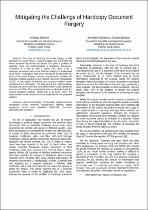JavaScript is disabled for your browser. Some features of this site may not work without it.
- ResearchSpace
- →
- Research Publications/Outputs
- →
- Conference Publications
- →
- View Item
| dc.contributor.author |
Dlamini, Nelisiwe P

|
|
| dc.contributor.author |
Mthetwa, Sthembile N

|
|
| dc.contributor.author |
Barbour, Graham D

|
|
| dc.date.accessioned | 2018-10-23T12:37:53Z | |
| dc.date.available | 2018-10-23T12:37:53Z | |
| dc.date.issued | 2018-08 | |
| dc.identifier.citation | Dlamini, N.P., Mthetwa, S.N. and Barbour, G.D. 2018. Mitigating the challenge of hardcopy document forgery. The International Conference on Advances in Big Data, Computing and Data Communications Systems (icABCD) 2018, 6-7 August 2018, Durban, South Africa | en_US |
| dc.identifier.uri | http://icabcd.org/wp-content/uploads/2018/07/icABCD-2018-Conference-Programme-6-7-August-2018-Durban-South-Africa-SUBJECT-TO-CHANGES.pdf | |
| dc.identifier.uri | http://hdl.handle.net/10204/10483 | |
| dc.description | Paper presented at the International Conference on Advances in Big Data, Computing and Data Communications Systems (icABCD) 2018, 6-7 August 2018, Durban, South Africa | en_US |
| dc.description.abstract | The issue of hardcopy document forgery is still prevalent. In South Africa, a series of cases have been reported where academic documents are forged. This poses a problem of integrity, trust and authentication of hardcopy documents. Therefore, it is vital to have a system that could verify a hardcopy document and ensure that the integrity is maintained at all times. Techniques have been introduced to eliminate the issue of document forgery, namely; cryptographic hashing, 2D Barcodes, Digital Signatures and Optical Character Recognition (OCR). In this paper, we present our proposed solution which comprises the 4 techniques. The first part of the implementation included the use of OCR and the experimental results yielded an accuracy of 100%. The experimental setup is described and the overall proposed solution. While this is on-going work, the experimental results demonstrate the feasibility of the proposed solution. | en_US |
| dc.language.iso | en | en_US |
| dc.relation.ispartofseries | Worklist;21290 | |
| dc.subject | Document integrity | en_US |
| dc.subject | 2D barcodes | en_US |
| dc.subject | Optical character recognition | en_US |
| dc.subject | OCR | en_US |
| dc.subject | Tesseract | en_US |
| dc.subject | Cryptographic hashing | en_US |
| dc.subject | Digital signatures | en_US |
| dc.subject | Secure hash algorithm | en_US |
| dc.subject | SHA-256 | en_US |
| dc.subject | Document generation | en_US |
| dc.subject | Document validation | en_US |
| dc.title | Mitigating the challenge of hardcopy document forgery | en_US |
| dc.type | Conference Presentation | en_US |
| dc.identifier.apacitation | Dlamini, N. P., Mthetwa, S. N., & Barbour, G. D. (2018). Mitigating the challenge of hardcopy document forgery. http://hdl.handle.net/10204/10483 | en_ZA |
| dc.identifier.chicagocitation | Dlamini, Nelisiwe P, Sthembile N Mthetwa, and Graham D Barbour. "Mitigating the challenge of hardcopy document forgery." (2018): http://hdl.handle.net/10204/10483 | en_ZA |
| dc.identifier.vancouvercitation | Dlamini NP, Mthetwa SN, Barbour GD, Mitigating the challenge of hardcopy document forgery; 2018. http://hdl.handle.net/10204/10483 . | en_ZA |
| dc.identifier.ris | TY - Conference Presentation AU - Dlamini, Nelisiwe P AU - Mthetwa, Sthembile N AU - Barbour, Graham D AB - The issue of hardcopy document forgery is still prevalent. In South Africa, a series of cases have been reported where academic documents are forged. This poses a problem of integrity, trust and authentication of hardcopy documents. Therefore, it is vital to have a system that could verify a hardcopy document and ensure that the integrity is maintained at all times. Techniques have been introduced to eliminate the issue of document forgery, namely; cryptographic hashing, 2D Barcodes, Digital Signatures and Optical Character Recognition (OCR). In this paper, we present our proposed solution which comprises the 4 techniques. The first part of the implementation included the use of OCR and the experimental results yielded an accuracy of 100%. The experimental setup is described and the overall proposed solution. While this is on-going work, the experimental results demonstrate the feasibility of the proposed solution. DA - 2018-08 DB - ResearchSpace DP - CSIR KW - Document integrity KW - 2D barcodes KW - Optical character recognition KW - OCR KW - Tesseract KW - Cryptographic hashing KW - Digital signatures KW - Secure hash algorithm KW - SHA-256 KW - Document generation KW - Document validation LK - https://researchspace.csir.co.za PY - 2018 T1 - Mitigating the challenge of hardcopy document forgery TI - Mitigating the challenge of hardcopy document forgery UR - http://hdl.handle.net/10204/10483 ER - | en_ZA |






